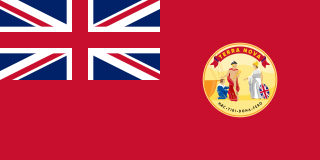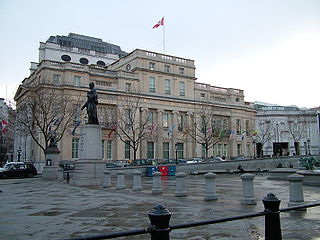
Newfoundland and Labrador is the easternmost province of Canada, in the country's Atlantic region. The province comprises the island of Newfoundland and the continental region of Labrador, having a total size of 405,212 square kilometres. In 2023, the population of Newfoundland and Labrador was estimated to be 533,710. The island of Newfoundland is home to around 94 per cent of the province's population, with more than half residing in the Avalon Peninsula. Labrador borders the province of Quebec, and the French overseas collectivity of Saint Pierre and Miquelon lies about 20 km (12 mi) west of the Burin Peninsula.

The Province of Lower Canada was a British colony on the lower Saint Lawrence River and the shores of the Gulf of Saint Lawrence (1791–1841). It covered the southern portion of the current Province of Quebec and the Labrador region of the current Province of Newfoundland and Labrador.

Canada has ten provinces and three territories that are sub-national administrative divisions under the jurisdiction of the Canadian Constitution. In the 1867 Canadian Confederation, three provinces of British North America—New Brunswick, Nova Scotia, and the Province of Canada —united to form a federation, becoming a fully independent country over the next century. Over its history, Canada's international borders have changed several times as it has added territories and provinces, making it the world's second-largest country by area.

Newfoundland was a Dominion in eastern North America, today the modern Canadian province of Newfoundland and Labrador. It was established on 26 September 1907, and confirmed by the Balfour Declaration of 1926 and the Statute of Westminster of 1931. It included the island of Newfoundland, and Labrador on the continental mainland. Newfoundland was one of the original dominions within the meaning of the Balfour Declaration, and accordingly enjoyed a constitutional status equivalent to the other dominions of the time.

The coat of arms of the province of Newfoundland and Labrador was originally granted by Garter King of Arms, during the reign of King Charles I, on 1 January 1637/8.

The High Commission of Canada in the United Kingdom is the diplomatic mission of Canada to the United Kingdom. It is housed at Canada House on Trafalgar Square in central London.

The Newfoundland National Convention of 1946 to 1948 was a forum established to decide the constitutional future of Newfoundland.
Charles H. Ballam was a Canadian union leader, officeholder and delegate at Newfoundland National Convention.

Prosperity returned to Canada during the Second World War. With continued Liberal governments, national policies increasingly turned to social welfare, including universal health care, old-age pensions, and veterans' pensions.
Frederick Gordon Bradley was a Canadian and Dominion of Newfoundland politician.

The Newfoundland referendums of 1948 were a series of two referendums to decide the political future of the Dominion of Newfoundland. Before the referendums, Newfoundland was in debt and went through several delegations to determine whether the country would join Canada, remain under British rule or regain independence. The voting for the referendums occurred on June 3 and July 22, 1948. The eventual result was for Newfoundland to enter into Confederation, which it did on March 31, 1949, becoming the tenth province of Canada.

By the arrangements of the Canadian federation, the Canadian monarchy operates in Newfoundland and Labrador as the core of the province's Westminster-style parliamentary democracy. As such, the Crown within Newfoundland and Labrador's jurisdiction is referred to as the Crown in Right of Newfoundland and Labrador, His Majesty in Right of Newfoundland and Labrador, or the King in Right of Newfoundland and Labrador. The Constitution Act, 1867, however, leaves many royal duties in the province specifically assigned to the sovereign's viceroy, the lieutenant governor of Newfoundland and Labrador, whose direct participation in governance is limited by the conventional stipulations of constitutional monarchy.

The province of Newfoundland and Labrador covers the period from habitation by Archaic peoples thousands of years ago to the present day.
In the Commonwealth of Nations, a high commissioner is the senior diplomat, generally ranking as an ambassador, in charge of the diplomatic mission of one Commonwealth government to another. Instead of an embassy, the diplomatic mission is generally called a high commission.

The bilateral relations between Canada and the United Kingdom have yielded intimate and frequently-co-operative contact since Canada gained independence in 1931. Canada was previously self-governing since 1 July 1867, the date that became Canada's independence day.
A Dominion was any of several self-governing nations of the British Empire. With the evolution of the British Empire into the Commonwealth of Nations, the dominions became independent states.
The Halifax Fisheries Commission was a joint international tribunal created by the United Kingdom and the United States in 1877 under Articles 22 and 23 of the Treaty of Washington (1871). The purpose of the Commission was to determine the amount of compensation, if any, to be paid by the United States to the United Kingdom under Article 18 of the Treaty in return for fishing privileges for Americans in the Atlantic waters off Canada and Newfoundland.

The High Commissioner of Newfoundland to the United Kingdom was the Dominion of Newfoundland's foremost diplomatic representative in the United Kingdom of Great Britain and Ireland, and was in charge of Newfoundland's diplomatic mission in the United Kingdom. Though Newfoundland was granted dominion status in 1907, it was not until November 22, 1918 that its High Commission was established in London with the appointment of Sir Edgar Rennie Bowring who took the position at his own expense. The High Commission was abolished in 1934 when Newfoundland's dominion status was suspended, along with self-government, and direct rule by London was established with the commission of government.

Thomas Matthew Mary Nangle was a Newfoundland cleric, military chaplain of the Royal Newfoundland Regiment during World War I, diplomat and later a Rhodesian politician and farmer.












